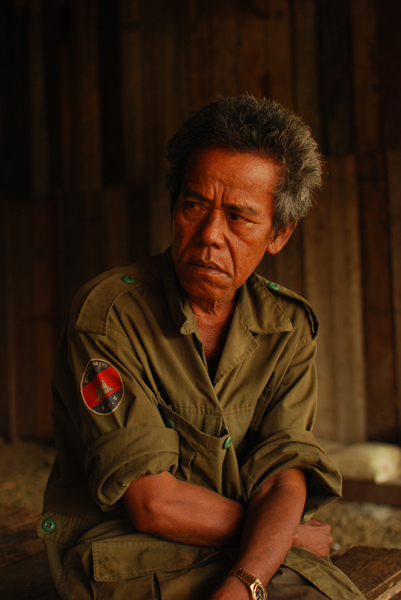
An apparent unwillingness to try two Khmer Rouge commanders for war crimes reflects a growing mood to bury Cambodia’s bloody past

SAMLOT, Cambodia–At the height of the monsoon season, Ta Sanh Cheung village looks much like thousands of others across Cambodia. Its main road – really more of a rutted track – coils through walls of lush foliage dotted with square wooden homes and fields of maize. Families sit in front of their homes stripping ears of corn and packing them into white sacks.
At a quiet end of the village stands a lavish three-storey wooden home, topped with satellite dishes and blue ceramic tiles. Its owner is a hunched 72-year-old named Meas Mut, the former navy commander of the Khmer Rouge – the ultra-communist movement that ruled Cambodia from 1975 to 1979 and left an estimated 1.7 million people dead.
As the UN-backed war crimes tribunal in Phnom Penh opens its second round of trials today, putting four senior surviving Khmer Rouge leaders in the dock, Meas Mut’s name has appeared in leaked tribunal documents naming him as a future war crimes suspect. Along with Sou Met, the ex-head of the Khmer Rouge air force, prosecutors accuse him of having a hand in the arrest, forced labour and death of tens of thousands of purged officials.
In a recent interview at his home in Ta Sanh Cheung, Meas Mut spoke willingly about his role under the regime, but said his conscience was clean. “I was a lower officer who was willing to protect Cambodia’s independence and neutrality … I was not a Khmer Rouge leader,” the former commander said calmly, rolling home-grown tobacco into a stubby cigarette. “If I did bad I couldn’t sleep here in a hammock. Somebody might throw a stone at me or sometime might take a knife and kill me. But I am living in safety.”
Meas Mut, who wore a white singlet and checked krama scarf, was one of last of the Khmer Rouge’s commanders to lay down his arms in the 1990s in return for a symbolic post in the Cambodian military. Since then, he has apparently experienced a Buddhist rebirth, paying for a new pagoda and offering sagely advice to locals. As we spoke, a book of Buddhist parables lay on a nearby chair, and he peppered his speech with religious aphorisms. It is a strange – maybe cynical – turn for a senior member of a regime that outlawed religion and killed tens of thousands of Buddhist monks.
But locals defended Meas Mut, describing him as a “good Buddhist” and a patriot. “Since we have lived here, we have never seen him do a bad deed,” said Suo Chok, a 54-year-old former Khmer Rouge fighter in a tattered T-shirt bearing the words “Let’s Build A Clean Society”. “If he sees us do something bad he calls us to his home and gives us advice.”
Suo Chok said talk of indicting Meas Mut at the Cambodian war crimes court – known formally as the Extraordinary Chambers in the Courts of Cambodia (ECCC) – had stirred unease in the village.
“As a soldier he never killed people – they just sent him to the front line to protect the border,” Suo Chok said. “They just accused him without evidence.”
Observers disagree, saying there is more than enough evidence to indict Meas Mut. “It’s not surprising he should deny his role, but he can’t deny the weight of evidence. He can’t deny the testimonies that run into the tens of thousands,” Khmer Rouge victims advocate Theary Seng said.
The bigger question, she said, was whether Meas Mut would ever see the inside of a courtroom. In the run-up to today’s trial, it is the future case against Meas Mut and Sou Met, known as Case 003, that is grabbing headlines. At least five Western staffers from the investigating judges’ office have reportedly resigned following a decision by the ECCC’s two co-investigating judges to close the Case 003 investigation in April.
Critics accuse the judges of conducting a superficial investigation – they claim no witness interviews or field studies were undertaken – as a prelude to burying the case under pressure from Cambodian Prime Minister Hun Sen. Last year, Hun Sen told visiting UN Secretary-General Ban Ki-Moon that indictments beyond the current case were “not allowed” – a view parroted by the court’s Cambodian judges.
Though Ban Ki Moon’s spokesman has defended the court’s independence, observers say its credibility is on the line in Case 003. “If the court is seen as not fulfilling its procedure … then it will taint the entire process, including Case 001 and Case 002,” said Anne Heindel, legal adviser for the Documentation Centre of Cambodia, which researches Khmer Rouge history. “There’s no way you can separate Case 003 out from what’s come before.”
It may be too early to say whether Meas Mut will live out his life in quiet retirement. But the controversy poses questions about how far down the chain the tribunal and its UN backers are willing or able to go.
Residents in Samlot said the trial of Meas Mut would be a step too far, and that the country’s horrific past was best left behind them. “I’m not interested in the Khmer Rouge court because everything is over already,” said Khieu Moeun, 61, another former Khmer Rouge soldier wearing a cast-off police uniform.
“I don’t want to be reminded.”
[Published in the South China Morning Post, June 27, 2011]


